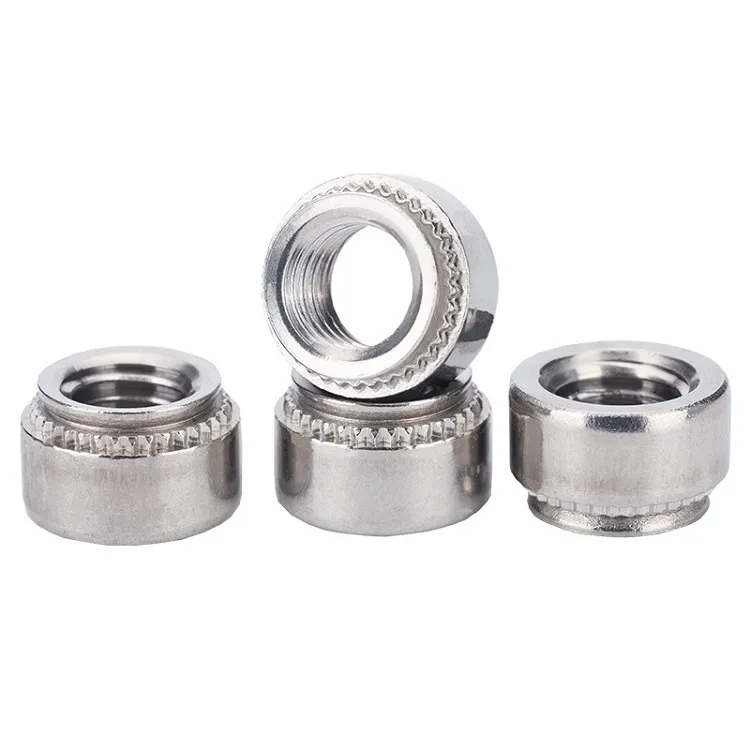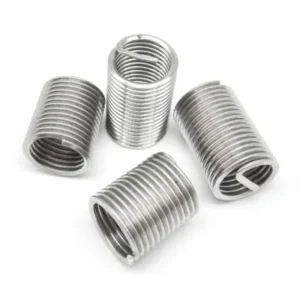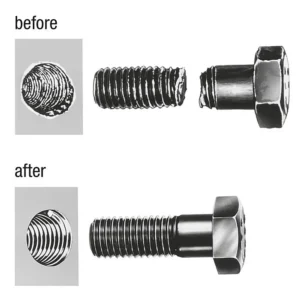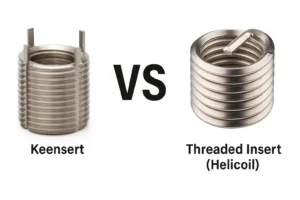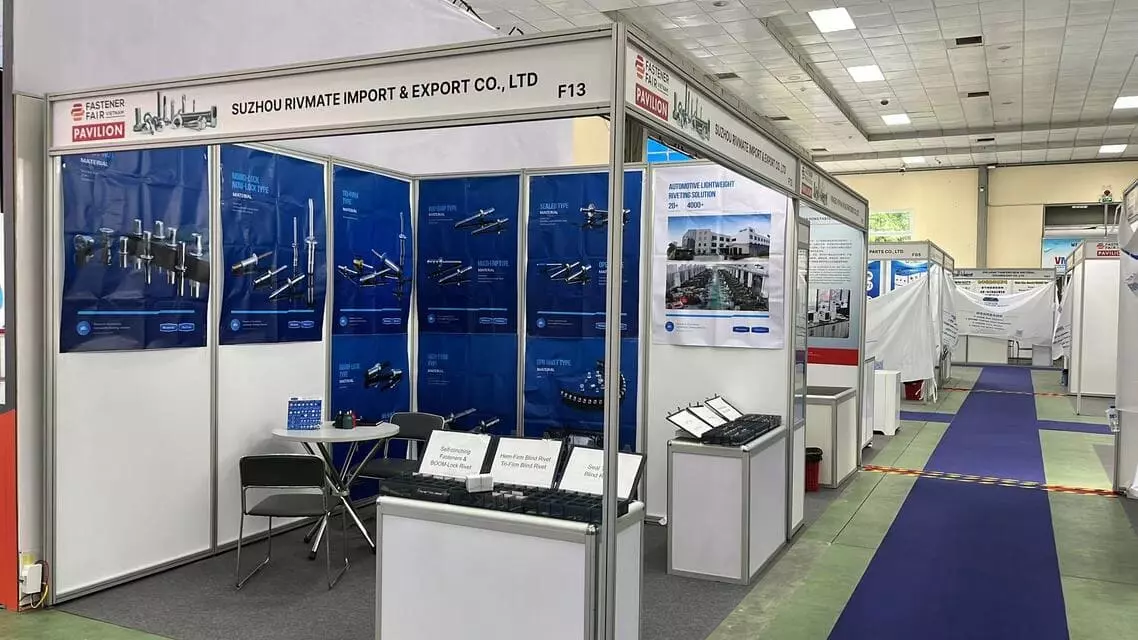How to Choose Self Clinching Nuts/PEM Nuts for Stainless Steel?
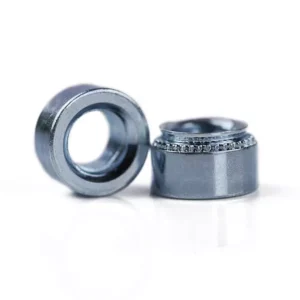
Leading Self-Clinching Fasteners Manufacturer and Supplier in China
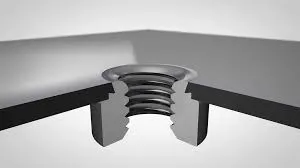
When working with stainless steel sheets, selecting the right PEM nuts for stainless steel is critical to ensuring a secure and long-lasting threaded connection. Due to the high hardness and resilience of stainless steel, not all self-clinching nuts are suitable for direct installation. This guide will walk you through the key factors—such as material compatibility, hardness requirements, minimum sheet thickness, and proper installation techniques—to help you choose the ideal PEM nuts for stainless steel applications.
Table of Contents
Self-clinching nuts, also commonly referred to as PEM nuts (a name popularized by the company PennEngineering), are specialized fasteners designed for thin metal sheet materials, widely used in industries such as electronics, electrical systems, automotive, and aerospace.
These nuts are installed by a cold press-in process, using the plastic deformation and geometric locking between the nut and the base metal to form a secure, non-rotating threaded connection. Their main features include:
a. Basic Principle
- Self-clinching nuts typically have locking teeth or knurled grooves on the outer surface. When pressed into a pre-punched hole under force, the surrounding sheet metal flows into these grooves;
- The plastic deformation of the base material creates a mechanical interlock, securing the nut in place;
- Once installed, no welding or rear-side access is needed, allowing for strong, one-sided assembly;
- Ideal for improving production efficiency in sheet metal applications.
b. Suitable Base Materials
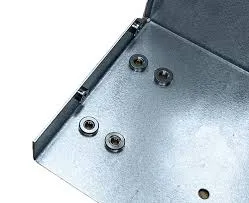
- Mild steel sheets
- Stainless steel sheets (requires high-strength nuts)
- Aluminum alloy sheets
- Metals that are difficult to weld or form with threads
- Cold press-in installation using a hydraulic press or punch press to embed the nut into the pre-drilled hole;
- The process involves no heat and does not affect the mechanical properties of the base material;
- Required press-in force depends on the sheet thickness, hardness, and nut type—typically ranging from 2 to 8 tons.
d. Typical Applications
- Electrical enclosures, server racks, and control cabinets
- Automotive seat frames, battery housings
- Electronic devices like laptops and displays
- Aerospace, railway, and structural assemblies requiring threaded connection
Why Does Stainless Steel Require Special Self-Clinching Nut Selection?
When applying self-clinching nuts (PEM nuts) to stainless steel sheets, material strength compatibility and press-fit feasibility must be carefully considered. Failure to do so may result in installation failure, slippage, or ineffective fastening. Below is an in-depth technical breakdown:
1. Stainless steel sheets have high hardness — standard nut materials may not anchor securely
- Common stainless steels like SUS 304 typically have a hardness of HV 150–190, equivalent to HRC 15–20.
- If using carbon steel or low-hardness stainless steel nuts (e.g., untreated SUS 302/304), the hardness may be too close to the base material, preventing proper metal flow and locking.
- It is recommended to use hardened materials such as SUS 410, SUS 416, or 17-4PH, with typical hardness values of HRC 36–45, which are 30%–50% harder than stainless base materials.
- Engineering principle: The hardness of the clinching nut should exceed the base sheet’s hardness by at least 20% to ensure proper deformation and anti-rotation anchoring.
2. Carbon steel nuts tend to slip or fail when pressed into stainless steel
- Test data shows that HV 180 carbon steel nuts used on HV 170–190 stainless sheets produce anti-rotation torque values far below standard (e.g., M4 ≤ 1.5 Nm), leading to slippage and ineffective anchoring.
- With similar hardness levels, insufficient metal flow occurs during installation, causing poor mechanical locking.
- PEM installation manuals explicitly state: “Do not install carbon steel PEM nuts into sheets harder than HB 90 (≈ HRC 10).”
3. Recommended nut materials and performance comparison
| Nut Material | Heat Treatment | Typical Hardness (HRC) | Recommended Sheet Material |
|---|---|---|---|
| Carbon Steel | None | HRC 10–15 | Mild steel, aluminum, copper |
| SUS 302 / 304 | None | HRC 15–20 | Mild steel, aluminum (not for stainless) |
| SUS 410 | Hardened & Tempered | HRC 36–42 | SUS 304 / SUS 316 stainless steel |
| 17-4PH | Age-Hardened | HRC 38–45 | High-hardness stainless & structural steel |
It is highly recommended to select SUS 410 or 17-4PH PEM nuts for stainless steel applications to meet both anti-rotation and pull-out requirements.
4. Recommended installation force and conditions for stainless PEM nuts
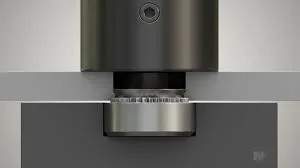
- Adequate installation pressure is critical to drive the nut into the base material and allow the sheet metal to flow into the clinch profile.
- For M5 nuts, the recommended press-in force is 20–30 kN; for M6, it’s 25–35 kN.
- If the force is too low, the nut may remain above the surface or fail to anchor properly.
- Hydraulic or pneumatic presses are strongly recommended, with controlled press depth and force (tolerance ±5%).
5. Summary: Ensure “Nut Hardness > Sheet Hardness” and match press-in load
- Using mismatched material can reduce pull-out strength by over 30%.
- Test results show that SUS 410 nuts installed on 1.5mm SUS 304 sheets can achieve 6.5–8.0 kN pull-out strength (M6).
- In contrast, carbon steel nuts under the same conditions typically achieve only 3.5–4.0 kN, presenting serious connection reliability risks.
Conclusion: For stainless steel sheets harder than HB 90 (approx. HRC 10), only hardened stainless PEM nuts should be used. Press-in installation should be performed with calibrated hydraulic or pneumatic equipment. Material mismatch is one of the most common causes of clinch nut failure.
How to Choose Self Clinching Nuts/PEM Nuts for Stainless Steel?
① Material and Hardness Matching of the Base Metal
When using self-clinching nuts on stainless steel base materials, the matching relationship between the nut material and the hardness of the base metal is crucial. Improper selection may cause the nut to not clinch properly, slip during rotation, or loosen and fail during long-term use.
a. Common Hardness Ranges of Stainless Steel Plates
| Material Grade | Type | Typical Hardness | Notes |
|---|---|---|---|
| SUS 304 | Austenitic Stainless Steel | HB 150–190 | Most common, good toughness but relatively high hardness |
| SUS 316 | Austenitic Stainless Steel | HB 160–200 | Better corrosion resistance, slightly higher hardness |
| SUS 301 (Work Hardened) | High-Strength Stainless Steel | HB 200–250 | Some spring steel grade, very demanding for self-clinching |
b. Nut Material Must Be Harder Than Base Material to Clinch Effectively
- The working principle of self-clinching nuts relies on cold forming to allow the nut to “bite” into the base metal surface, creating local metal flow and a clinching collar structure that provides torque resistance and prevents loosening.
- If the nut material hardness is less than or close to the base metal hardness, the following issues may occur:
- Incomplete clinching;
- Anti-rotation teeth or grooves fail to cut into the base material;
- The nut rotates with the bolt and falls off;
- Long-term failure due to stress relaxation.
c. Recommended Nut Materials and Hardness Reference
| Nut Material | Type | Recommended Base Material | Hardness Range | Characteristics |
|---|---|---|---|---|
| Low Carbon Steel (Untreated) | Mild Steel | Not suitable for stainless steel plates | < HB 130 | Prone to slipping |
| Heat Treated Carbon Steel (e.g., C1045) | Medium-High Carbon Steel | SUS 304/316 | HRC 35–45 | Cost-effective, high strength |
| SUS 410 Stainless Steel | Martensitic | All stainless steel plates | HRC 36–42 (HB 370–430) | High hardness, corrosion-resistant, specially designed for stainless steel clinching |
| Special Stainless Steel (e.g., A286) | Austenitic Precipitation Hardening | High-strength plates (e.g., SUS 301-H) | HRC 45+ | For extreme loads and high-temperature applications |
d. Practical Selection Advice:
- Ensure the nut material hardness ≥ base metal hardness + 20%–30%;
- For SUS 304 plates (HB 150–190), select nuts with hardness HB ≥ 300, such as heat-treated carbon steel or SUS 410 nuts;
- For high-strength work-hardened plates (e.g., SUS 301-H), prioritize SUS 410 or higher grade stainless steel nuts;
- Avoid using ordinary carbon steel nuts (HB < 160), as they are prone to clinching failure.
② Plate Thickness Requirements
Self-clinching nuts form a stable clinching collar through cold forming. The plate thickness directly affects the completeness of the clinching collar formation and the overall strength of the fastener. Plates that are too thin or too thick may cause installation failure or insufficient connection strength.
a. Recommended Minimum Plate Thickness for Different Nut Sizes
| Thread Size | Minimum Plate Thickness (mm) | Notes |
|---|---|---|
| M3 | ≥ 0.8 | Suitable for thin metal sheets; requires adequate local plastic deformation |
| M4 | ≥ 1.0 | Common minimum thickness, ensures sufficient clinching strength |
| M5 | ≥ 1.2 | Suitable for medium-thickness plates, provides good fastening performance |
| M6 | ≥ 1.5 | For thicker plates, offers higher load capacity |
| M8 and above | ≥ 2.0 | For heavy-duty and high-strength structures, requires thicker plates |
b. Risks of Too Thin Plates
- Insufficient plate thickness limits the local plastic deformation during clinching, leading to incomplete collar formation;
- The nut cannot achieve enough bite force, resulting in loose connections or nut rotation and detachment;
- Thin plates concentrate stresses, which may cause cracks, bulges, or local tears near the clinching collar, affecting structural strength and appearance;
- For ultra-thin plates (< 0.8 mm), specialized thin-sheet self-clinching nuts or alternative joining methods (e.g., welding, adhesive bonding) are recommended.
c. Considerations for Too Thick Plates
- If the plate thickness exceeds the maximum clinching range of the nut, the tail of the nut cannot fully plastically deform, causing a weak clinching collar;
- Thicker plates increase the required clinching force significantly, which may overload or damage the installation equipment;
- For thick plate applications, longer self-clinching nuts or alternative fasteners (e.g., weld studs, threaded inserts) are recommended to ensure reliability.
d. Multi-layer Plate Stacking
- When multiple layers are stacked, the clinching collar formation must consider the total thickness fitting within the nut’s grip range;
- Prevent slipping between layers by using spacers or anti-slip coatings if necessary;
- Accurate measurement of total thickness and selection of the correct nut size are essential.
e. Practical Installation Recommendations
- Confirm actual plate thickness and tolerance range during design to avoid mismatched nut grip range selection;
- Allow an installation tolerance of 0.2–0.3 mm to accommodate manufacturing and assembly variances;
- Ensure the plate is free from defects, and hole size and shape comply with nut specifications for smooth insertion.
Which Self-Clinching Nut Series Are Suitable for Stainless Steel?
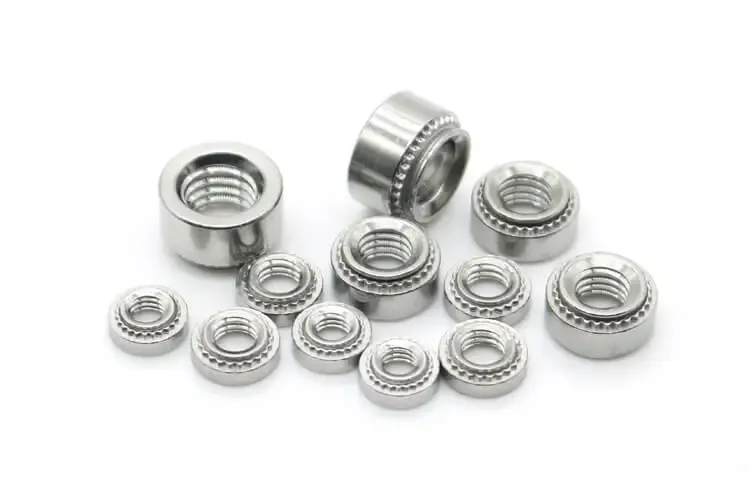
Due to differences in material, design, and performance, various self-clinching nut series have distinct suitability for stainless steel sheets. Choosing the right series is crucial to ensure secure installation and long-term stability. The detailed analysis is as follows:
S Series (400 Series Stainless Steel Material)
- Made of 400-series martensitic stainless steel, this series features high hardness and is specially designed for hard substrates like stainless steel sheets.
- It offers strong tensile strength and anti-rotation performance, forming a stable clinching structure on hard, less deformable sheet metals.
- Suitable for common stainless steels such as SUS 304, SUS 316, and other hard metal sheets.
- Exhibits excellent corrosion resistance, ideal for industrial applications requiring high environmental resistance.
CLS Series (Carbon Steel with Zinc Plating)
- Primarily designed for aluminum or mild steel sheets, made from carbon steel with zinc plating for rust protection.
- The material hardness and corrosion resistance are insufficient for hard and corrosion-resistant stainless steel substrates.
- Using CLS series on stainless steel may lead to nut slipping, poor installation tightness, and premature failure; thus, it is not recommended.
SP Series (Stainless Steel Material)
- Made from high-quality stainless steel, suitable for hard metals and applications demanding higher strength and corrosion resistance.
- Designed with enhanced anti-rotation features to withstand vibration and torque loads, ensuring reliable and safe connections.
- Ideal for harsh environments such as marine, chemical, and high-vibration equipment stainless steel connections.
SC Series (Stainless Steel Material, Suitable for Thick Sheets)
- Also made from stainless steel, this series is specifically designed for thicker sheets with reinforced clinching edges.
- Provides increased clamping force and durability, suitable for heavy loads and repeated use.
- Particularly suited for thick stainless steel structural parts and industrial equipment, ensuring long-term connection stability.
Summary Recommendations:
- For stainless steel sheets, prioritize S, SP, or SC series self-clinching nuts to ensure hardness compatibility and corrosion resistance.
- Avoid using CLS or other carbon steel nuts to prevent installation failure, loosening, and corrosion issues.
- Choose the appropriate series and model based on specific sheet thickness, strength requirements, and environmental conditions to guarantee connection quality and service life.
What Are the Key Installation Tips for Self-Clinching Nuts?
Installing self-clinching nuts properly is essential for ensuring a strong and durable connection, especially when used with stainless steel materials. Here are the key installation tips with detailed technical considerations:
①. Avoid Using Rivet Tools or Hammering for Installation
- Self-clinching nuts are designed to be installed using a hydraulic press or punch press that applies uniform vertical pressure.
- Using rivet tools or hammering can cause uneven force distribution, leading to deformation of the nut or damage to the base material.
- For example, improper force application can reduce the clinching strength by up to 30%, causing early failure.
- Recommended press force depends on nut size; e.g., M6 nuts typically require ~10-15 kN of consistent force for optimal embedding.
②. Ensure Nut and Hole Are Perpendicularly Aligned
- The nut must be precisely aligned perpendicular to the pre-punched hole to prevent skewing during pressing.
- Misalignment exceeding 2° can cause incomplete clinching or tilted nuts, which reduces anti-rotation effectiveness by 40% or more.
- Proper fixturing or alignment tools can reduce misalignment errors to under 0.5°, ensuring consistent quality.
③. Apply Uniform Vertical Pressure During Installation
- Uniform pressure ensures even metal flow around the nut’s clinching ring to form a solid, lock-edge structure.
- Pressure deviation of more than ±5% across the nut circumference can cause localized stress concentrations, leading to cracks or insufficient locking.
- Pressure holding time during installation is usually 2-5 seconds, depending on material thickness, to allow metal flow and stress relaxation.
④. Post-Installation Checks: Ensure Close Contact and No Looseness
- After installation, verify that the nut sits flush against the material surface with no gaps larger than 0.1 mm.
- Check for rotation or looseness by applying a torque equal to at least 1.5 times the expected service load (e.g., for M6, test torque ≥ 10 Nm).
- A nut that moves or rotates under this load indicates insufficient clinching or hole size tolerance issues and should be replaced.
⑤. Additional Considerations
- Hole size tolerance must be controlled within ±0.05 mm of the nut’s outer diameter to guarantee proper clinching and anti-rotation performance.
- Cleanliness: Burr height inside holes should be less than 0.1 mm, and surfaces should be free of oils or contaminants to prevent slippage or weak adhesion.
- Environmental factors such as temperature (recommended 20-25°C) can affect metal ductility during pressing; extreme cold may increase brittleness, requiring adjusted press parameters.
Do You Have Any Questions?
Let Us Solve Your Problem
What Are the Performance Advantages of Self-Clinching Nuts for Stainless Steel?
Self-clinching nuts exhibit several significant performance advantages when used with stainless steel, making them a preferred fastening solution in many industrial applications. The specific advantages are as follows:
1. High Torque Resistance and Excellent Anti-Loosening Performance
Self-clinching nuts are firmly embedded into the base material through a cold-forming process, creating a mechanical locking structure that effectively prevents the nut from rotating or loosening during vibration or repeated assembly and disassembly. Especially when properly designed and installed in hard stainless steel substrates, they offer outstanding anti-rotation capabilities.
2. No Welding Required, Preventing Base Material Damage
Since self-clinching nuts are installed by cold pressing without welding or high-temperature processes, they avoid deformation, heat-affected zone corrosion, and complex welding procedures. This improves production efficiency while preserving the structural integrity and surface quality of the stainless steel base material.
3. Single-Side Installation for Improved Assembly Efficiency
Self-clinching nuts require installation from only one side of the base material, making them ideal for applications with limited space or complex structures. Single-side installation simplifies the assembly process, reduces labor costs, and lowers installation difficulty, making them well-suited for automated production lines.
4. High Internal Thread Strength Suitable for Frequent Assembly and Disassembly
Made from high-quality materials with precise manufacturing, the internal threads of self-clinching nuts are strong and wear-resistant, capable of withstanding frequent bolt tightening and loosening without damage. This feature is especially valuable for equipment requiring regular maintenance or periodic disassembly.
FAQs
Q1: What if the stainless steel sheet is too hard and the nut can’t be pressed in?
- This is one of the most common issues. Stainless steel sheets such as SUS304 have high hardness (typically HB150–190). If the clinching nut is not harder than the base material, it may fail to embed or may loosen over time.
- Solutions:
- Use self-clinching nuts made of harder materials, such as SUS410 stainless steel or heat-treated carbon steel (≥ HRC35);
- Make sure to use a hydraulic press or stamping machine—avoid hammering or using rivet guns;
- Ensure that the hole size is precise and the surface is clean, free from oil or burrs that could interfere with proper seating.
Q2: How to check if the nut is properly installed?
Installation quality directly affects safety and joint reliability. You can verify the installation with these checks:
- Visual inspection: The nut flange should sit flush against the material surface without any visible gaps;
- Rotation test: Apply a specified torque using a torque wrench (e.g., ≥ 2 Nm for M4, ≥ 3 Nm for M5); the nut should not spin;
- Pull-out test: Use a force gauge to ensure the nut meets minimum pull-out strength (e.g., ≥ 3 kN for M4, ≥ 4.5 kN for M5);
- Sampling inspection: In mass production, test at least 5% of installed nuts to ensure consistency.
Q3: Are there corrosion-resistant self-clinching nuts?
Yes. For corrosive environments, material selection is key:
- SUS410 stainless steel nuts: Suitable for most humid or mildly corrosive conditions;
- SUS316 stainless steel nuts (available from premium brands): Ideal for marine, chemical, or high-salinity environments;
- Surface-treated carbon steel nuts (e.g., with Dacromet or zinc-nickel coatings): These offer moderate corrosion resistance but are generally not as effective as stainless steel.
Q4: Can self-clinching nuts be reused?
- The nut body cannot be reused once installed—it forms a permanent lock and cannot be reinstalled if removed;
- However, the internal thread can be reused for multiple bolt assemblies and removals, as long as the threads remain undamaged;
- If the nut loosens or falls out, a new nut must be installed—do not reuse the old one.
Conclusion
When using self-clinching nuts on stainless steel sheets, it is essential to prioritize whether the nut material is harder than the base material and whether it ensures reliable press-in performance. Improper material selection or installation methods can result in failure to embed, slipping, or loosening of the nut, ultimately compromising the strength and durability of the entire structure.
Considering overall performance and corrosion resistance, we recommend giving priority to S Series or SP Series stainless steel self-clinching nuts, which offer enhanced anti-rotation capabilities. Only by selecting the appropriate nut during the design stage and applying professional, standardized installation procedures can you achieve a strong, secure, and highly efficient fastening solution on stainless steel panels.
Do You Have Any Questions?
Let Us Solve Your Problem
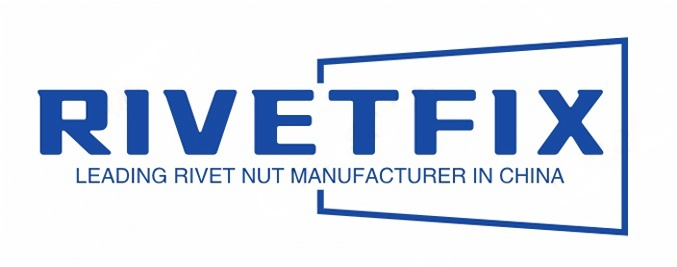
With 15+ years of experience in fastener manufacturing, Rivetfix has grown into a trusted global supplier. Today, we have a dedicated team of 200+ skilled production workers and 40+ professional sales representatives, ensuring seamless service and reliable supply.
Our vision is simple yet powerful: to provide the highest-quality fasteners at competitive prices to customers worldwide. In doing so, we combine precision manufacturing, efficient operations, and exceptional customer support. As a result, we are committed to helping businesses build stronger, more cost-effective solutions. Through this approach, we aim to consistently exceed customer expectations and foster long-term partnerships.
Partnering with Rivetfix means stable supply, top-quality fasteners, and custom solutions. We help you cut costs, boost efficiency, and enhance durability. Expect on-time delivery, expert support, and innovation. Buy PEM fasteners now!
Get High Quality Rivet Nuts Quote!
Send Your Rivet Nut Request
For more than 20 years, Rivetfix has helped customers solve many rivet nuts sourcing needs and technical challenges.
Have a question? Contact us and we’ll provide you with the perfect solution.
